Catarina Belém
FairGBM: Gradient Boosting with Fairness Constraints
Sep 19, 2022



Abstract:Machine Learning (ML) algorithms based on gradient boosted decision trees (GBDT) are still favored on many tabular data tasks across various mission critical applications, from healthcare to finance. However, GBDT algorithms are not free of the risk of bias and discriminatory decision-making. Despite GBDT's popularity and the rapid pace of research in fair ML, existing in-processing fair ML methods are either inapplicable to GBDT, incur in significant train time overhead, or are inadequate for problems with high class imbalance. We present FairGBM, a learning framework for training GBDT under fairness constraints with little to no impact on predictive performance when compared to unconstrained LightGBM. Since common fairness metrics are non-differentiable, we employ a "proxy-Lagrangian" formulation using smooth convex error rate proxies to enable gradient-based optimization. Additionally, our open-source implementation shows an order of magnitude speedup in training time when compared with related work, a pivotal aspect to foster the widespread adoption of FairGBM by real-world practitioners.
Weakly Supervised Multi-task Learning for Concept-based Explainability
Apr 26, 2021



Abstract:In ML-aided decision-making tasks, such as fraud detection or medical diagnosis, the human-in-the-loop, usually a domain-expert without technical ML knowledge, prefers high-level concept-based explanations instead of low-level explanations based on model features. To obtain faithful concept-based explanations, we leverage multi-task learning to train a neural network that jointly learns to predict a decision task based on the predictions of a precedent explainability task (i.e., multi-label concepts). There are two main challenges to overcome: concept label scarcity and the joint learning. To address both, we propose to: i) use expert rules to generate a large dataset of noisy concept labels, and ii) apply two distinct multi-task learning strategies combining noisy and golden labels. We compare these strategies with a fully supervised approach in a real-world fraud detection application with few golden labels available for the explainability task. With improvements of 9.26% and of 417.8% at the explainability and decision tasks, respectively, our results show it is possible to improve performance at both tasks by combining labels of heterogeneous quality.
Promoting Fairness through Hyperparameter Optimization
Mar 23, 2021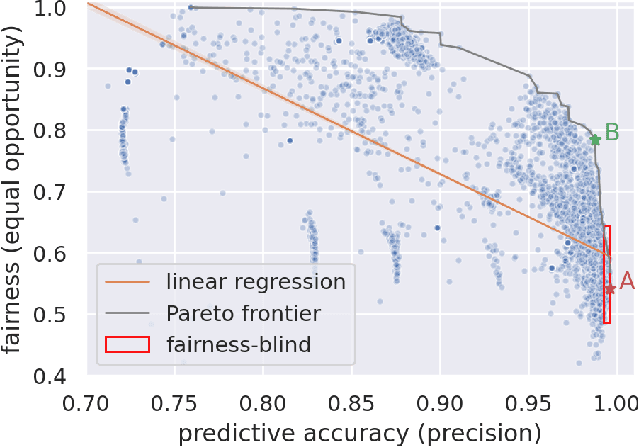
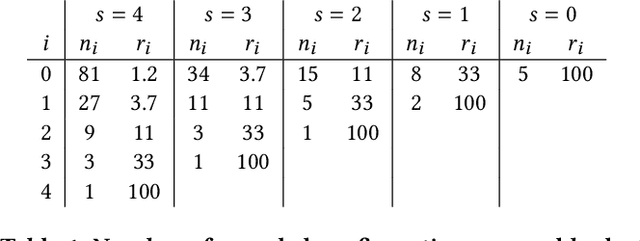
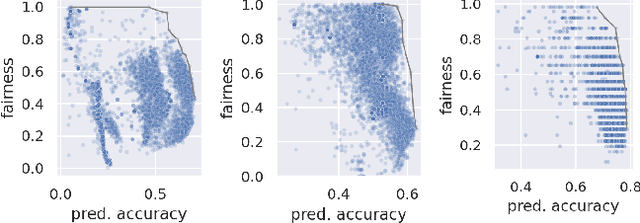
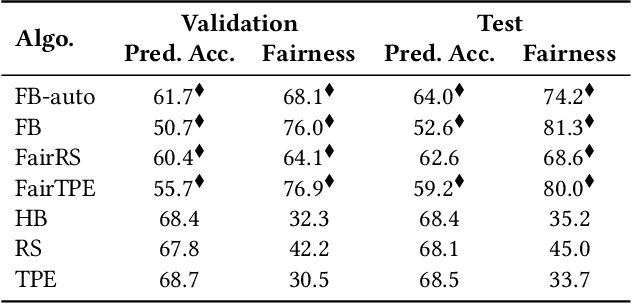
Abstract:Considerable research effort has been guided towards algorithmic fairness but real-world adoption of bias reduction techniques is still scarce. Existing methods are either metric- or model-specific, require access to sensitive attributes at inference time, or carry high development and deployment costs. This work explores, in the context of a real-world fraud detection application, the unfairness that emerges from traditional ML model development, and how to mitigate it with a simple and easily deployed intervention: fairness-aware hyperparameter optimization (HO). We propose and evaluate fairness-aware variants of three popular HO algorithms: Fair Random Search, Fair TPE, and Fairband. Our method enables practitioners to adapt pre-existing business operations to accommodate fairness objectives in a frictionless way and with controllable fairness-accuracy trade-offs. Additionally, it can be coupled with existing bias reduction techniques to tune their hyperparameters. We validate our approach on a real-world bank account opening fraud use case, as well as on three datasets from the fairness literature. Results show that, without extra training cost, it is feasible to find models with 111% average fairness increase and just 6% decrease in predictive accuracy, when compared to standard fairness-blind HO.
How can I choose an explainer? An Application-grounded Evaluation of Post-hoc Explanations
Jan 22, 2021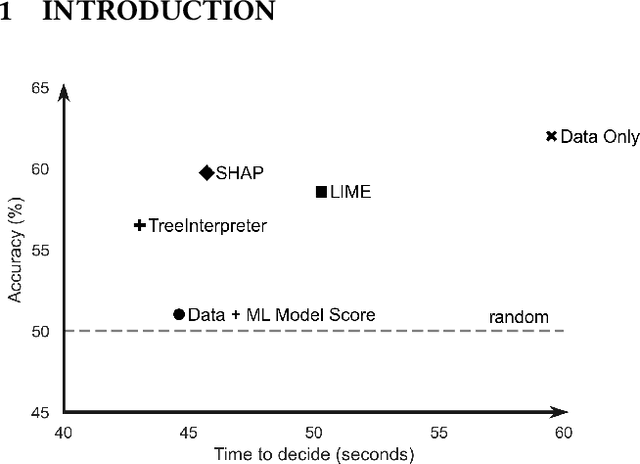

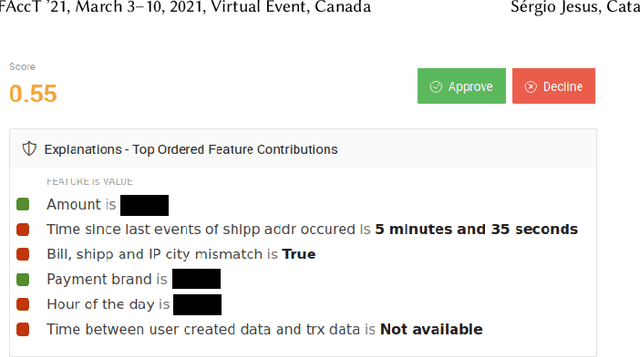

Abstract:There have been several research works proposing new Explainable AI (XAI) methods designed to generate model explanations having specific properties, or desiderata, such as fidelity, robustness, or human-interpretability. However, explanations are seldom evaluated based on their true practical impact on decision-making tasks. Without that assessment, explanations might be chosen that, in fact, hurt the overall performance of the combined system of ML model + end-users. This study aims to bridge this gap by proposing XAI Test, an application-grounded evaluation methodology tailored to isolate the impact of providing the end-user with different levels of information. We conducted an experiment following XAI Test to evaluate three popular post-hoc explanation methods -- LIME, SHAP, and TreeInterpreter -- on a real-world fraud detection task, with real data, a deployed ML model, and fraud analysts. During the experiment, we gradually increased the information provided to the fraud analysts in three stages: Data Only, i.e., just transaction data without access to model score nor explanations, Data + ML Model Score, and Data + ML Model Score + Explanations. Using strong statistical analysis, we show that, in general, these popular explainers have a worse impact than desired. Some of the conclusion highlights include: i) showing Data Only results in the highest decision accuracy and the slowest decision time among all variants tested, ii) all the explainers improve accuracy over the Data + ML Model Score variant but still result in lower accuracy when compared with Data Only; iii) LIME was the least preferred by users, probably due to its substantially lower variability of explanations from case to case.
Teaching the Machine to Explain Itself using Domain Knowledge
Nov 27, 2020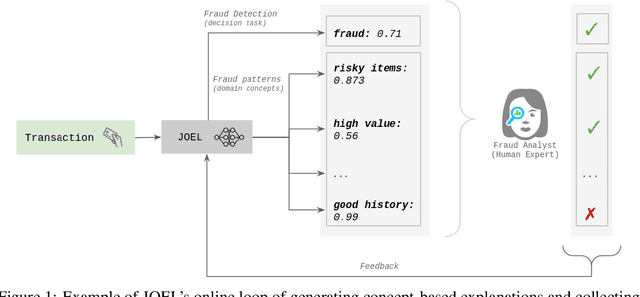


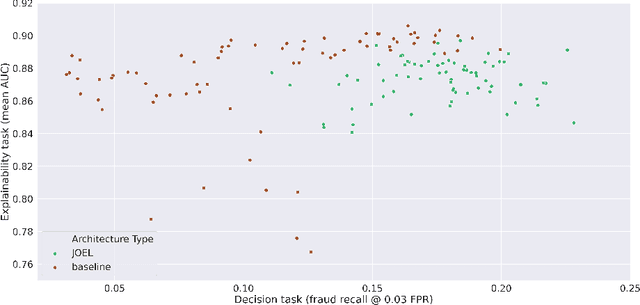
Abstract:Machine Learning (ML) has been increasingly used to aid humans to make better and faster decisions. However, non-technical humans-in-the-loop struggle to comprehend the rationale behind model predictions, hindering trust in algorithmic decision-making systems. Considerable research work on AI explainability attempts to win back trust in AI systems by developing explanation methods but there is still no major breakthrough. At the same time, popular explanation methods (e.g., LIME, and SHAP) produce explanations that are very hard to understand for non-data scientist persona. To address this, we present JOEL, a neural network-based framework to jointly learn a decision-making task and associated explanations that convey domain knowledge. JOEL is tailored to human-in-the-loop domain experts that lack deep technical ML knowledge, providing high-level insights about the model's predictions that very much resemble the experts' own reasoning. Moreover, we collect the domain feedback from a pool of certified experts and use it to ameliorate the model (human teaching), hence promoting seamless and better suited explanations. Lastly, we resort to semantic mappings between legacy expert systems and domain taxonomies to automatically annotate a bootstrap training set, overcoming the absence of concept-based human annotations. We validate JOEL empirically on a real-world fraud detection dataset. We show that JOEL can generalize the explanations from the bootstrap dataset. Furthermore, obtained results indicate that human teaching can further improve the explanations prediction quality by approximately $13.57\%$.
A Bandit-Based Algorithm for Fairness-Aware Hyperparameter Optimization
Oct 22, 2020



Abstract:Considerable research effort has been guided towards algorithmic fairness but there is still no major breakthrough. In practice, an exhaustive search over all possible techniques and hyperparameters is needed to find optimal fairness-accuracy trade-offs. Hence, coupled with the lack of tools for ML practitioners, real-world adoption of bias reduction methods is still scarce. To address this, we present Fairband, a bandit-based fairness-aware hyperparameter optimization (HO) algorithm. Fairband is conceptually simple, resource-efficient, easy to implement, and agnostic to both the objective metrics, model types and the hyperparameter space being explored. Moreover, by introducing fairness notions into HO, we enable seamless and efficient integration of fairness objectives into real-world ML pipelines. We compare Fairband with popular HO methods on four real-world decision-making datasets. We show that Fairband can efficiently navigate the fairness-accuracy trade-off through hyperparameter optimization. Furthermore, without extra training cost, it consistently finds configurations attaining substantially improved fairness at a comparatively small decrease in predictive accuracy.
 Add to Chrome
Add to Chrome Add to Firefox
Add to Firefox Add to Edge
Add to Edge